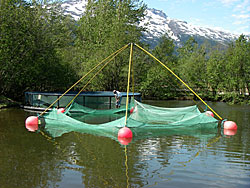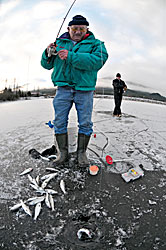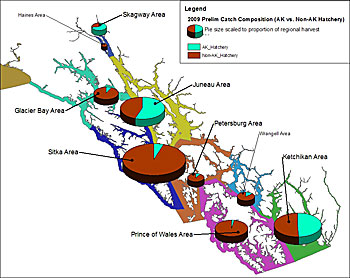Alaska Fish & Wildlife News
February 2010
Enhancing Opportunities for
Southeast Alaska Sport Fisheries

Hatcheries and various stocking programs provide angling opportunity throughout the state. These programs are funded by the Alaska Department of Fish and Game’s Sport Fish Division. The construction now underway of two state-of-the-art, state-owned hatchery facilities in Anchorage and in Fairbanks will provide fish to satisfy angler demands in both the Interior and Southcentral regions. Hatcheries are also used to produce fish to provide additional opportunities to sport anglers in the Southeast region, but rather than being state owned and operated, are run by private operators under contract to the state. Long-time residents may remember that the Alaska Legislature created the Fisheries Rehabilitation, Enhancement, and Development (FRED) Division within the ADF&G in 1971. The primary reason was to produce salmon to rehabilitate depleted stocks. Shortly after the formation of the FRED Division new funding was provided to the department to construct hatchery facilities across the state and to staff them. The bond packages for those programs had one of the highest voter approval rates seen to date. Through the 1970s and 1980s FRED and Sport Fish Division collaborated on a number of projects statewide to improve opportunities for commercial and sport users. But because of continual budget declines and declining revenues across state agencies in the late ‘80s and early ‘90s, FRED Division was merged with the Commercial Fisheries Division in 1993. Eventually the operation of state-run hatcheries for commercial production of salmon was eliminated in 1995 because of continual declines in vital state funding. Nearly all the state-owned facilities were transferred to Private-Non-Profit (PNP) hatchery associations after the state ceased operations in 1995. The intent was to keep key programs going in order to sustain production needed (and depended on) by a myriad of users. There are currently four state-owned facilities in Southeast Alaska that are operated by PNPs – Crystal Lake near Petersburg, Klawock on Prince of Wales Island, Snettisham south of Juneau, and Hidden Falls on southeast Baranof Island. Crystal Lake Hatchery (CLH) is the only hatchery operating without a PNP permit. CLH historically has produced many king salmon, but the nature of the operation did not present any opportunities for cost recovery to cover annual operating expenses for the operator. Because of its production value to sport users, another approach was needed. CLH is now operated under contract by Southern Southeast Regional Aquaculture Association (SSRAA) using funds provided in part by Sport Fish Division. Central to the Sport Fish Division’s mission, and certainly an important core service, Southeast regional staff have worked with hatchery operators to collaboratively fund enhancement opportunities for sport anglers – mostly for king salmon, but also some coho salmon and trout. The sources of the funds have varied over the years, but include: angler license revenues (Fish and Game funds); Sport Fish Restoration funds (Dingell-Johnson); Pacific Coastal Salmon Recovery Act funds (AKSSF); and most recently, the Sport Fish Enterprise Account funds generated by the sport fishing license surcharge approved by the Alaska Legislature under SB147 in 2005. Nearly $1.4 million will be expended in FY10 through cooperative agreements established with hatchery operators in Southeast Alaska. Regional staff collaborate with several PNP hatcheries in the region, as well as the Northern Southeast Alaska Regional Aquaculture Associations (NSRAA) and SSRAA, to pay for collecting broodstock, incubating eggs, and rearing salmon fry to smolt stage for release at various remote locations. There are eight release sites for king salmon that are part of the Southeast Alaska sport fisheries enhancement program. These provide vast opportunities in the marine boat and saltwater shoreline fisheries in the region and at the same time provide protection to wild stocks through adherence to a suite of guideline policies covering issues such as genetics and disease. The overall effort of the program is multi-purpose: it is essential to help meet the mandates of international treaty agreements with Canada; it assists in helping meet domestic fishery management goals relative to allocation across the user groups in the face of increasing demands; it relieves fishing pressure and exploitation on local wild stocks; and it provides sustained and additional opportunities in years of low and high abundance due to varying ocean conditions relative to survival rates. Annual sport harvests of king salmon in the Haines/Skagway, Juneau, Petersburg, and Ketchikan areas are frequently dominated by Alaska hatchery fish. In 2009, 49 percent of the king salmon harvested in the Ketchikan-area recreational fisheries, and 58 percent of the king salmon harvested in the Juneau area came from Alaska hatcheries. With increasing sport effort, that is no doubt good news for local wild stocks. For example, the composition of the king salmon harvest in the Juneau area is on average in excess of 50 percent, whereby the majority of the fishing effort for hatchery king salmon is concentrated in designated “Terminal Harvest Areas” (THAs). The THA management regime in the Juneau sport fishery helps reduce fishing pressure on wild fish returning to the nearby Taku River, helping to ensure that escapement will be met in that river system as mandated under terms of the US/Canada Pacific Salmon Treaty and through state fishery policy dictated by the Alaska Board of Fisheries. Furthermore, the allowable harvest regulations within the THA are relaxed because the effort targets Alaska hatchery fish and not wild stocks; an important consideration because Alaska hatchery-produced king salmon do not count toward the harvest quota mandated by the Treaty. Similar management strategies are used in Ketchikan, Petersburg, Skagway, and the newest THA site in Lutak Inlet near Haines, to be established in 2010/2011. In 2007, over 540,000 angler-days were spent sport fishing in Southeast Alaska by residents and nonresidents. The total economic benefit anglers brought to the region was in excess of $273.5M. The total number of king salmon harvested by sport anglers was 82,848 fish, and nearly 21,000 were contributed by Alaska hatcheries in Southeast Alaska – more than a quarter of the total regional king salmon harvest. Another program that benefits sport anglers from Sport Fish Division’s enhancement program is “Family/Kid Fishing Day” events that are presented throughout the state as part of the national “Fishing Day” campaign. These events generally occur during the first weekend in June. In Juneau, Twin Lakes is stocked with 10,000 catchable-size (6-8 inches and an average weight of 100 grams) king salmon just prior to the event. The Juneau stocking is done through cooperative agreement between ADF&G and Macaulay Salmon Hatchery (DIPAC), and has existed since 1996. Similar to marine releases, the stocking of smolt into Twin Lakes is funded through the federal Sport Fish Restoration Program (taxes on fishing equipment and small engine fuels), and in part through sales of sport fishing licenses, king salmon stamps, and guide license fees. DIPAC stocks the lake once again in the fall with 5,000 king smolts that provide opportunity for a winter ice fishery, which in years with favorable ice conditions provides opportunity beyond the typical summer season. Family Fishing Day programs occur annually at Twin Lakes in Juneau, City Park Ponds in Ketchikan, and Swan Lake in Sitka, where fish are stocked into small isolated ponds to provide opportunities for both kids and adults alike. These events generally draw 250 to 300 people at each location annually, and gear and instruction is provided to those new to the sport. The importance of hatchery-produced king salmon is the greatest in areas where the abundance of wild king salmon and fishery catch rates are low. The most practical method for maximizing the sport harvest of stocked fish is to release smolts in areas where large sport fisheries currently exist, and where terminal area fisheries can develop. These programs and sites are also chosen to minimize impacts on naturally spawning stocks of king salmon. Needless to say, programs administered by the Sport Fish Division provide opportunities to recreational anglers through the release of hatchery-produced fish.


Subscribe to be notified about new issues
Receive a monthly notice about new issues and articles.
